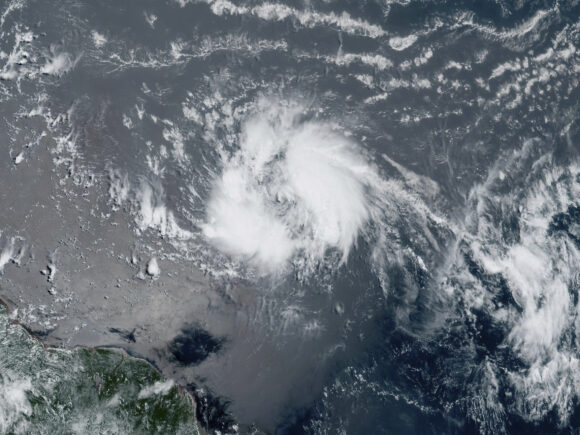Non-peak (secondary) perils and record-setting weather and climate events drove global insured losses from natural catastrophes to an estimated $123 billion in 2023, the fourth consecutive year to exceed $100 billion, according to Gallagher Re’s annual Natural Catastrophe and Climate Report.
The report said that six of the top 10 costliest insured events were severe convective storms (SCS) – one of those secondary perils – in the United States.
Of the total estimated insured losses, private insurers covered $110 billion while public insurance entities covered $13 billion.
The global economic cost of all natural perils was estimated at $357 billion – the eighth consecutive year when global losses surpassed $300 billion, Gallagher Re said.
Munich Re: Insured Price Tag for Natural Disasters Was $95B in 2023 With Economic Cost of $250B
When looking solely at climate and weather events, which excludes losses from earthquakes and other non-atmospheric-driven events, insured losses were estimated at $116 billion, while economic costs reached an estimated $301 billion. (Overall economic losses include insured losses).
“We continue to witness an increase in the severity and high-impact frequency of natural catastrophe events. These effects bring multifaceted and complex challenges to the re/insurance industry, as the importance of blending today’s view of risk with the anticipated downstream implications of tomorrow grows more critical,” commented Gallagher Re’s Chief Science Officer Steve Bowen in a statement.
Severe Convective Storms
Diving into the drivers of the losses in 2023, Gallagher Re said the SCS peril was the dominant factor, making up an estimated 58% of global insured losses. This translates to a record-setting $71 billion, of which the US accounted for $60 billion. In fact, six of the top 10 costliest insured events of 2023 were SCS events in the US.
“‘Peak’ perils are still anticipated to drive the highest individual event losses. However, the continued growth of damage from ‘non-peak/secondary’ perils, such as SCS, is changing the way we view and plan for natural catastrophe risk,” Bowen continued. “It also increases the importance of analytics and catastrophe modeling to properly gauge how a combination of climate change-influenced event behavior and socioeconomic parameters are leading to higher loss potentials.”
Protection Gap
The February earthquake sequence that affected Turkey and Syria was the most expensive event on an economic basis, with losses estimated at $46.2 billion, but insurance only covered $6.1 billion of the overall cost, Gallagher Re noted.
This natural catastrophe was a significant contributor to the 66% worldwide protection gap – the portion of economic costs from events not covered by insurance. Other events that drove the year’s protection gap included the Marrakech-Safi earthquake in Morocco, Typhoon Doksuri which led to major flooding in China, and Hurricane Otis in Mexico.
“While we continue to witness an expansion of insurance protection into vulnerable parts of the world, there remain considerable gaps in coverage that leave many developing countries highly exposed to catastrophe risk,” Bowen said.
“The need for more guaranteed climate or natural catastrophe financing to mitigate or adapt to a more complex world of natural hazards becomes more critical by the day. The growth of private and public sector partnerships bringing new insurance options to underserved communities is a promising trend that needs to further accelerate,” he continued.
Additional findings from the report include:
- Globally, 2023 set records with 66 individual billion-dollar economic loss events and 34 individual billion-dollar insured loss events from all natural perils.
- Last year marked the warmest year on record (for the modern era dating to 1850) at 1.35°C (2.43°F) above the pre-historical baseline (1850-1900).
- The combination of anomalous heat and prolonged drought conditions aided in the worst wildfire season in Canada’s modern record — burning 18.5 million hectares (45.7 million acres) of land.
- Hurricane Otis in Mexico became the costliest insured event on record for the nation.
- Typhoon Doksuri was preliminarily the costliest typhoon on record to impact mainland China, with most losses driven by inland flood.
Related:
Was this article valuable?
Here are more articles you may enjoy.


 Surging Oil Tanker Insurance Points to Growing Black Sea Chaos
Surging Oil Tanker Insurance Points to Growing Black Sea Chaos  The Return Period for An LA Wildfire-Scale Event May Be Shorter Than You Think
The Return Period for An LA Wildfire-Scale Event May Be Shorter Than You Think  Storm Goretti Batters Europe With Violent Winds, Power Cuts
Storm Goretti Batters Europe With Violent Winds, Power Cuts  Palantir Poaching Suit Called ‘Scare’ Tactic by Ex-Employees
Palantir Poaching Suit Called ‘Scare’ Tactic by Ex-Employees 